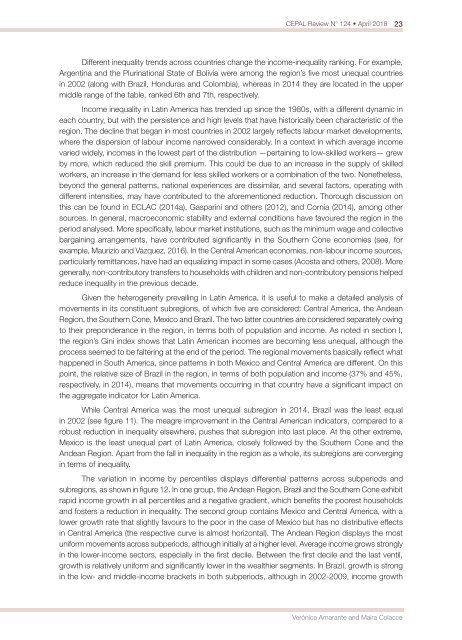CEPAL Review no. 124
April 2018
April 2018
You also want an ePaper? Increase the reach of your titles
YUMPU automatically turns print PDFs into web optimized ePapers that Google loves.
<strong>CEPAL</strong> <strong>Review</strong> N° <strong>124</strong> • April 2018<br />
23<br />
Different inequality trends across countries change the income-inequality ranking. For example,<br />
Argentina and the Plurinational State of Bolivia were among the region’s five most unequal countries<br />
in 2002 (along with Brazil, Honduras and Colombia), whereas in 2014 they are located in the upper<br />
middle range of the table, ranked 6th and 7th, respectively.<br />
Income inequality in Latin America has trended up since the 1980s, with a different dynamic in<br />
each country, but with the persistence and high levels that have historically been characteristic of the<br />
region. The decline that began in most countries in 2002 largely reflects labour market developments,<br />
where the dispersion of labour income narrowed considerably. In a context in which average income<br />
varied widely, incomes in the lowest part of the distribution —pertaining to low-skilled workers— grew<br />
by more, which reduced the skill premium. This could be due to an increase in the supply of skilled<br />
workers, an increase in the demand for less skilled workers or a combination of the two. Nonetheless,<br />
beyond the general patterns, national experiences are dissimilar, and several factors, operating with<br />
different intensities, may have contributed to the aforementioned reduction. Thorough discussion on<br />
this can be found in ECLAC (2014a), Gasparini and others (2012), and Cornia (2014), among other<br />
sources. In general, macroeco<strong>no</strong>mic stability and external conditions have favoured the region in the<br />
period analysed. More specifically, labour market institutions, such as the minimum wage and collective<br />
bargaining arrangements, have contributed significantly in the Southern Cone eco<strong>no</strong>mies (see, for<br />
example, Maurizio and Vázquez, 2016). In the Central American eco<strong>no</strong>mies, <strong>no</strong>n-labour income sources,<br />
particularly remittances, have had an equalizing impact in some cases (Acosta and others, 2008). More<br />
generally, <strong>no</strong>n-contributory transfers to households with children and <strong>no</strong>n-contributory pensions helped<br />
reduce inequality in the previous decade.<br />
Given the heterogeneity prevailing in Latin America, it is useful to make a detailed analysis of<br />
movements in its constituent subregions, of which five are considered: Central America, the Andean<br />
Region, the Southern Cone, Mexico and Brazil. The two latter countries are considered separately owing<br />
to their preponderance in the region, in terms both of population and income. As <strong>no</strong>ted in section I,<br />
the region’s Gini index shows that Latin American incomes are becoming less unequal, although the<br />
process seemed to be faltering at the end of the period. The regional movements basically reflect what<br />
happened in South America, since patterns in both Mexico and Central America are different. On this<br />
point, the relative size of Brazil in the region, in terms of both population and income (37% and 45%,<br />
respectively, in 2014), means that movements occurring in that country have a significant impact on<br />
the aggregate indicator for Latin America.<br />
While Central America was the most unequal subregion in 2014, Brazil was the least equal<br />
in 2002 (see figure 11). The meagre improvement in the Central American indicators, compared to a<br />
robust reduction in inequality elsewhere, pushes that subregion into last place. At the other extreme,<br />
Mexico is the least unequal part of Latin America, closely followed by the Southern Cone and the<br />
Andean Region. Apart from the fall in inequality in the region as a whole, its subregions are converging<br />
in terms of inequality.<br />
The variation in income by percentiles displays differential patterns across subperiods and<br />
subregions, as shown in figure 12. In one group, the Andean Region, Brazil and the Southern Cone exhibit<br />
rapid income growth in all percentiles and a negative gradient, which benefits the poorest households<br />
and fosters a reduction in inequality. The second group contains Mexico and Central America, with a<br />
lower growth rate that slightly favours to the poor in the case of Mexico but has <strong>no</strong> distributive effects<br />
in Central America (the respective curve is almost horizontal). The Andean Region displays the most<br />
uniform movements across subperiods, although initially at a higher level. Average income grows strongly<br />
in the lower-income sectors, especially in the first decile. Between the first decile and the last ventil,<br />
growth is relatively uniform and significantly lower in the wealthier segments. In Brazil, growth is strong<br />
in the low- and middle-income brackets in both subperiods, although in 2002-2009, income growth<br />
Verónica Amarante and Maira Colacce


















